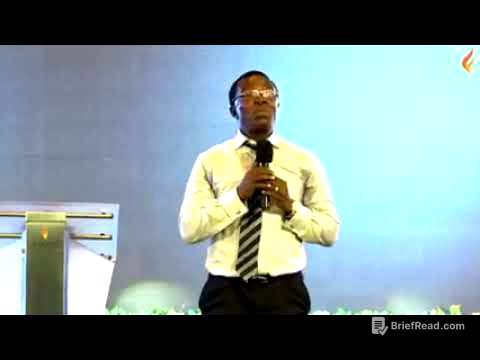TLDR;
This lecture discusses the importance of joint mobility for functional performance, injury prevention, and rehabilitation. It covers factors affecting mobility, goals of mobility training, and various assessment techniques like goniometry, inclinometry, functional movement screens, and joint play testing. The lecture emphasizes the need for early identification of deficits, comparison with the other side, and selection of tools based on the goal and population. It also presents a case scenario of a long-distance runner with knee stiffness and ankle injury, illustrating how to assess and address mobility and flexibility issues.
- Joint mobility is crucial for functional performance, injury prevention, and rehabilitation.
- Assessment techniques include goniometry, inclinometry, functional movement screens, and joint play testing.
- Early identification of deficits and individualized training programs are essential.
Introduction: Naman's Case and Course Overview [0:15]
The lecture begins by introducing Naman, a long-distance runner experiencing knee stiffness and an old ankle injury. It poses questions about assessing range of motion and differentiating between mobility and flexibility issues. The lecture serves as an introduction to a course on physical medicine and rehabilitation, specifically focusing on flexibility and joint mobility. The learning objectives include understanding mobility training basics, factors affecting mobility, training goals, assessment techniques, and their application through a case scenario.
Importance and Basics of Joint Mobility [1:30]
Joint mobility is vital for functional performance, preventing injury, and enhancing biomechanical movement in sports. It is also a key component in rehabilitation and return-to-sports protocols. Joint mobility refers to the active range of motion available at a joint, influenced by joint structure, capsule, ligaments, soft tissue, and neuromuscular control. It differs from flexibility, which is passive muscle extensibility. Mobility is a broader concept, with flexibility being a subset of it.
Factors Affecting and Goals of Mobility Training [2:27]
Factors affecting mobility include joint structure and shape, capsule and ligament compliance, muscle bulk and tone, neural activation and control, and pathological changes around the joint. The goals of mobility training are to restore optimal range of motion (dictated by sports demand), enhance motor control, improve tissue quality, and prevent unnecessary biomechanical compensation. Assessment is important for early identification of deficits and instituting the right training to prevent biomechanical compensation.
Types of Mobility and Assessment Techniques Overview [5:09]
There are two types of mobility: active (performed by the individual) and passive (assisted by an examiner or external resistance). Assessment techniques include joint-specific range of motion testing using goniometers or inclinometers, functional movement screens, and joint play for assessing accessory movements within the joint. It's important to compare with the other side and select tools based on the goal and population being assessed.
Goniometry: Gold Standard for Range of Motion Measurement [7:00]
Goniometry is the gold standard for measuring range of motion. A goniometer has two arms: a stationary arm and a mobile arm. One arm is fixed to the proximal segment of the joint, and the center is placed over a fixed anatomical bony landmark. The individual moves the distal segment, and the mobile arm measures the extreme ranges of motion in degrees. Standardized protocols are crucial for reliable measurements, widely used in sports medicine and physiotherapy clinics.
Inclinometry: Gravity-Based Angle Measurement [8:28]
An inclinometer is an angle measurement device that is gravity-dependent. It comes in two types: a bubble level and a digital level. Digital levels are more accurate. Inclinometry is commonly used for spine assessments.
Functional Movement Screen: Identifying Movement Asymmetries [9:00]
The functional movement screen identifies asymmetries in movement and joint mobility using seven movement patterns: deep squat, hurdle step, inline lunge, active straight leg raise, trunk stability push-up, rotatory stability, and shoulder mobility. Each pattern is rated from 1 to 3, with a maximum total score of 21. A score of 2 or below indicates the need for corrective exercises. A total score of less than 14 is a cutoff, and lower scores may predispose individuals to injuries. It's a good screening tool before starting the season to establish a baseline and correct deficiencies.
Joint Play Testing: Assessing Accessory Movements [10:49]
Joint play testing assesses accessory movements within a joint, including roll, glide, and spin. These movements are biomechanically possible within a joint and can be tested using joint play techniques. Each joint has a specific position for testing, generally fixing the proximal segment and moving the distal segment. Techniques include traction, compression, or glide. This helps identify the room available for segments to move within the joint and estimates the support given by the capsule and ligaments.
Soft Tissue Assessment: Influences on Joint Mobility [12:22]
Soft tissue assessment involves palpating around the joint along the lines of fascia and ligaments to identify thickening, trigger points, and tightness. This helps assess biomechanical corrections due to stress, force transfer changes, injuries, or improper techniques. Palpating along the planter fascia, for example, can reveal tightness.
Recording, Monitoring, and Red Flags in Mobility Assessment [13:45]
Recording and monitoring mobility over time are essential to track progress and the effectiveness of interventions. Periodical testing helps assess the impact of sports training and technique corrections. Red flags during mobility assessment include pain, abrupt end fields during joint play, and gross asymmetry between sides, which warrant further evaluation.
Case Scenario: Applying Assessment Techniques to Naman [15:39]
The lecture revisits Naman's case, a long-distance runner with knee stiffness and an old ankle injury. It suggests checking the range of motion using a goniometer for hip flexion/extension and internal/external rotation, knee flexion/extension, and ankle dorsiflexion/plantarflexion. A foot postural index can assess the structural integrity of the foot. Muscle length tests (e.g., Ely's test, straight leg raise) can differentiate between flexibility and mobility issues. Joint play testing at the knee and ankle is important, especially given Naman's history of ankle injury.
Corrective Measures and Addressing Specific Issues [20:04]
Corrective measures depend on whether the issue is flexibility or mobility-related. For ankle dorsiflexion problems, stretching exercises can relax and lengthen the calf muscle. If the foot posture index indicates pronation or supination, footwear modifications like stabilizing footwear or heel counters can be used. Strengthening foot muscles is also important. For reduced hip flexion, hamstring tightness should be addressed with stretching exercises. ITB tightness can be managed with foam rolling and therapeutic exercises. Ankle joint injuries may require strengthening exercises and proprioceptive training.
Preventing Injuries and Incorporating Technology [24:51]
A systematic approach helps prevent injuries through early detection of deficits and limitations. Mobility programs in warm-ups and stretching programs in cool-downs are beneficial. Technology, such as digital goniometers, motion capture technology, and wearables, can complement monitoring efforts and provide real-time and remote assessment capabilities.
Sport-Specific Demands and Conclusion [26:31]
Assessment techniques should focus on the specific demands of the sport. Overhead athletes require attention to shoulder joint mobility, while endurance and contact sports need different approaches. Mobility is essential for optimal function, and assessment and individualization are key. Range of motion, joint play, and soft tissue assessment help address the cause holistically. Including mobility in sports training programs improves performance and lowers injury risk.









